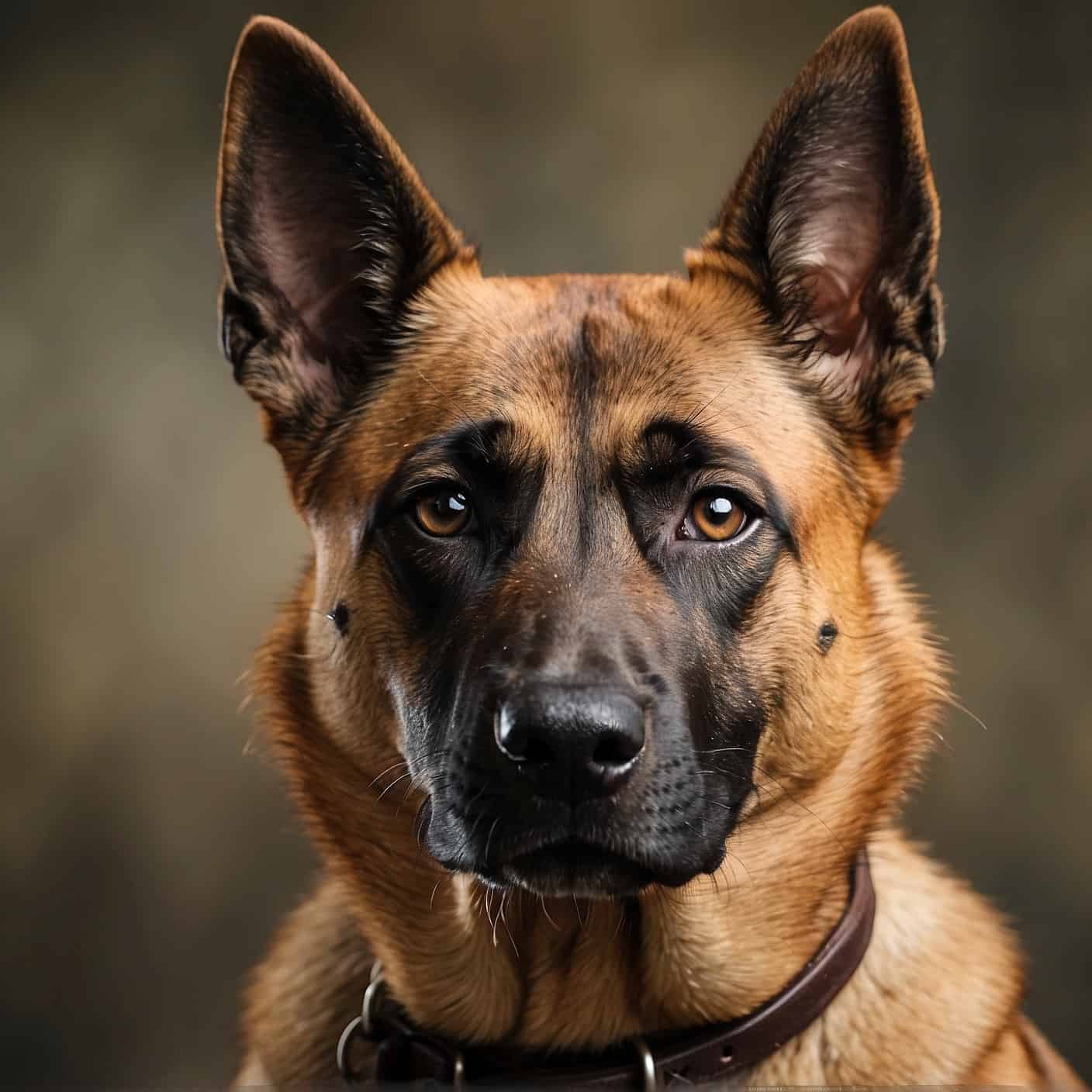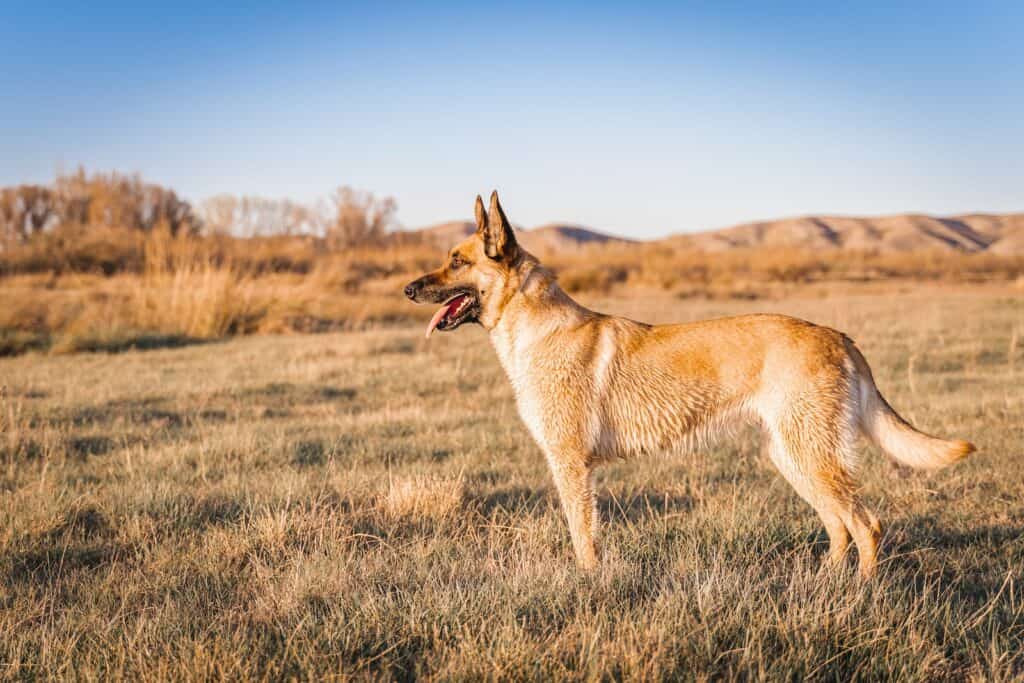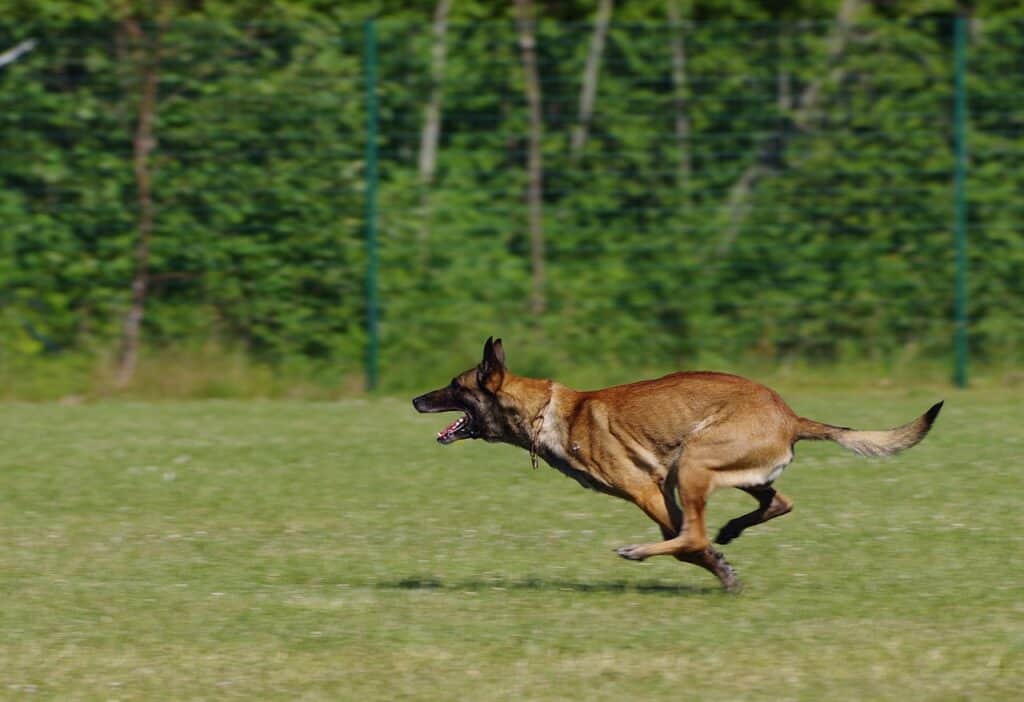The Belgian Malinois, an epitome of determination, unwavering dedication, and extraordinary versatility, has become a treasured favorite among dog lovers and professionals in various fields. With its roots in Belgium, distinctive physical characteristics, and a remarkable range of temperament traits, this breed has firmly established itself as a valued partner in both law enforcement and as a loyal family companion.

| Category (Explanation) | Breed Information |
|---|---|
| Year of Breed Conception | 19th century |
| Country of Origin | Belgium |
| Weight (lbs & kg) (Male) | 60-80 lbs (27-36 kg) |
| Weight (lbs & kg) (Female) | 40-60 lbs (18-27 kg) |
| Coat Type | Short double coat |
| Color Variations | Fawn to mahogany with a black mask |
| Shedding Level (Low, Moderate, High) | Moderate |
| Height (cm & in) | 22-26 inches (56-66 cm) |
| Breed Size | Medium to large |
| Trainability (Low, Moderate, High) | High |
| Mental Needs (Low, Moderate, High) | High |
| Intelligence Level (Low, Moderate, High) | High |
| Energy Level (Low, Moderate, High) | High |
| Agility (Low, Moderate, High) | High |
| Loyalty (Low, Moderate, High) | High |
| Playfulness (Low, Moderate, High) | Moderate |
| Exercise Needs | Vigorous exercise and mental stimulation |
| Guarding Proficiency (Low, Moderate, High) | High |
| Sociability with Children (Low, Moderate, High) | Moderate |
| Barking Level (Low, Moderate, High) | Moderate |
| Digging Tendency (Low, Moderate, High) | Moderate |
| Destructive Behavior (Low, Moderate, High) | Moderate |
| Drooling Level (Low, Moderate, High) | Low |
| Obedience Level (Low, Moderate, High) | High |
| Apartment Friendly (Yes/No) | Can adapt to apartment living with sufficient exercise |
| Inherent Prey Drive | High |
| Physical Risk to Others (Low, Moderate, High) | Low |
| Travel Fatality Risk (Low, Moderate, High) | Low |
| Allergen Potential | Low |
| Health Concerns (List of Common Health Concerns) | Hip Dysplasia, Eye Problems, Epilepsy |
| Average Life Expectancy (Life Expectancy in Years) | 10-14 years |
Woof Mastery is reader supported and our articles may contain affiliate links.
Instead of running third party ads that we have no control of we only use links from high-quality companies we are directly partnered with. Making use of these links come at no cost to you our reader, and in many cases have the extra benefit of discounted rates or sign up bonuses.
If you’re interested you can read more about our affiliate policy here.
We appreciate your support and always insure that the products and services we recommend are high-quality, helpful and relevant to the subject at hand!
The history of the Belgian Malinois is one of dedication and service. These dogs hail from Belgium and were initially developed as herding dogs, known for their intelligence and agility.
Their name pays homage to the Belgian city of Malines, where the breed was cultivated. Belgian Malinois quickly demonstrated their value as working dogs and became widely used in police, military, and search and rescue roles.
Throughout both World Wars and in the modern era, Belgian Malinois have shown their mettle in various roles, including as guard dogs and loyal companions. Their history is one of unwavering loyalty and service to humanity.

Belgian Malinois stand out for their unwavering dedication and unwavering work ethic. They are often chosen as police and military dogs due to their keen intelligence and ability to perform a wide range of tasks with precision.
Yet, beneath their tough exterior, they possess a deep sense of loyalty and affection for their handlers, making them remarkable partners in both professional and family settings.
Belgian Malinois have a strong tradition as working dogs. Originating in Belgium, they have been used for various tasks such as herding, guarding, and police work. Their strength, intelligence, and determination made them ideal for these roles. In contemporary society, they are often employed as police and military dogs due to their keen senses and unwavering dedication to their handlers.
Belgian Malinois are celebrated for their exceptional personalities. They are known for their unwavering loyalty, intelligence, and a strong work ethic. These dogs are often described as having a deep sense of duty and a desire to protect and serve their handlers.
Their intelligence and trainability make them ideal for complex tasks, and their affectionate nature with their owners is evident. While they may be reserved with strangers, they are fiercely loyal to their families. Belgian Malinois are characterized by their dedication, determination, and a strong sense of responsibility, epitomizing the perfect blend of loyalty and duty.
Belgian Malinois are intelligent and extremely focused working dogs. They are loyal, protective, and thrive on challenges. These dogs are often used in police and military roles due to their courage and trainability.
They can be reserved with strangers and need early socialization to ensure they are well-adjusted and not overly protective or aggressive. They require a lot of physical and mental exercise.
Belgian Malinois are medium-sized dogs with a well-muscled and agile build. They have a proportionate, wedge-shaped head with alert, almond-shaped eyes. Ears are triangular and typically stand erect.
They have a short, dense coat in a fawn to mahogany color with a black mask and ears. Their tail is usually straight and tapered.
Males typically stand between 24 to 26 inches (61-66 cm) at the shoulder and weigh between 60 to 80 pounds (27-36 kg), while females are slightly smaller and lighter.
Belgian Malinois have a strong and alert appearance, reflecting their role as working dogs.
Belgian Malinois typically have a short, fawn to mahogany coat with a black mask and ears. They may also have a small amount of white on the chest, chin, or toes.
Belgian Malinois typically have a solid fawn to mahogany coat without distinct patterns.
Belgian Malinois have a moderate shedding level. They shed year-round with increased shedding during seasonal transitions. Regular grooming and brushing can help control shedding and keep their coat healthy.
Belgian Malinois have a short, dense coat that requires minimal grooming. Grooming habits for this breed include:
1. Brushing: Occasional brushing with a slicker brush is sufficient to remove loose fur and maintain coat health.
2. Bathing: Bathe Belgian Malinois when necessary, using a dog-specific shampoo and thorough rinsing.
3. Ears: Check and clean their ears regularly to prevent wax buildup or infections using a veterinarian-recommended ear cleaning solution.
4. Nails: Keep their nails trimmed to a comfortable length to maintain proper gait and prevent discomfort.
5. Teeth: Brush their teeth regularly to ensure dental health and prevent bad breath. Dental chews or toys can be helpful.
6. Tail and Paw Care: Maintain cleanliness in the tail and paw areas, inspecting for any signs of irritation or injury.
Belgian Malinois have a very high activity level and thrive on physical and mental challenges. Key points about their activity level include:
1. Exercise Needs: Belgian Malinois require daily vigorous exercise to stay happy and healthy. Activities should be high-intensity, such as running, agility, and advanced obedience.
2. Energy Level: They are known for their exceptional energy levels and need regular, intense exercise to burn off energy.
3. Working Heritage: Historically, Belgian Malinois were bred for herding and working on farms. They excel in various dog sports, protection work, and search and rescue.
4. Mental Stimulation: In addition to physical exercise, mental challenges through obedience training and problem-solving activities are essential.
5. Working Dogs: They are often employed as working dogs in law enforcement and military roles due to their high drive and endurance.
Belgian Tervurens are highly intelligent dogs with exceptional cognitive abilities. Here are some key points about their intelligence:
Belgian Tervurens’ exceptional intelligence and agility make them excel in a variety of roles. Training, socialization, and mental stimulation are essential for their well-rounded development.
Belgian Malinois are highly intelligent and need constant mental stimulation. Engage them in obedience training, agility courses, and complex tasks to keep their minds active.
Social Interaction: They are social dogs and require regular interaction with their human family. Isolation can lead to anxiety and behavioral issues.
Exercise: Mental challenges are as important as physical exercise. Provide them with tasks that require problem-solving and focus.
Training and Obedience: Belgian Malinois thrive on obedience training, which not only provides mental stimulation but also reinforces their bond with their owners. Consistency and positive reinforcement are essential.
Enter The Woof Mastery

Considering a Belgian Malinois? Here are important factors to know:
1. Activity Level: Malinois are extremely active and need daily exercise and mental stimulation to prevent boredom-related issues.
2. Training Requirements: Training is crucial due to their intelligence and strong work ethic. They excel in obedience and agility.
3. Space: Malinois need room to move, making them better suited for homes with yards.
4. Shedding: They have a moderate shedding level, and regular grooming can help manage their coat.
5. Work or Sport: Many Malinois find fulfillment in work or dog sports, so consider their need for mental challenges.
Belgian Malinois, known for their strong working abilities, may pose a physical risk to others if not properly socialized, trained, or managed. The risk assessment factors include:
1. Protective Instinct: Belgian Malinois may have a protective instinct, especially towards their family or territory. Proper training is essential to manage this instinct.
2. Socialization: Early and thorough socialization is critical to ensure Belgian Malinois are comfortable around people and other animals. Poor socialization can lead to fear or aggression.
3. Training: Obedience training is crucial to teach Belgian Malinois appropriate behavior and ensure they respond to commands. Well-trained dogs are less likely to engage in aggressive behavior.
4. Owner Responsibility: Responsible ownership involves vigilance and awareness of the dog’s behavior, especially in public settings.
5. Breed-Specific Legislation (BSL): In some areas, Belgian Malinois may be subject to breed-specific legislation due to their working and protective nature. Owners should be aware of local laws and regulations.
6. Individual Variability: Each dog is unique, and behavior can vary. Responsible ownership, proper training, and socialization are essential to minimize the potential physical risk to others.
Belgian Malinois are often protective and loyal, which can make them good family dogs. However, they are highly active and may require careful supervision around small children due to their energy levels. With proper socialization and training, they can coexist well with kids.
Belgian Malinois are generally capable swimmers. They have a strong and athletic build, making them proficient in the water. Many may enjoy swimming and can stay afloat. However, always supervise your dog in the water, as their comfort level and abilities may differ from one dog to another.
Early and positive training will help your Belgian Malinois puppy become a well-behaved and devoted companion.
Belgian Malinois are typically considered moderate to high in terms of noisiness. They are alert and may bark to signal potential threats or intruders. Their protective nature can lead to vocalization when they sense danger or unfamiliar people.
Belgian Malinois thrive in homes that provide:
Challenges:
When traveling with Belgian Malinois, consider these factors:
Belgian Malinois are generally healthy, but they can be prone to certain health issues, including:
Proper nutrition is essential for Belgian Malinois. Follow these nutritional habits:
Proper nutrition is essential for the health and well-being of Belgian Malinois.
Breed-specific laws (BSL) may impact Belgian Malinois in some regions, with regulations varying depending on local jurisdictions. Common BSL restrictions for Belgian Malinois may include:
BSL is typically motivated by concerns about public safety and perceived risks associated with specific breeds, including Belgian Malinois. However, it’s important to note that Belgian Malinois are not inherently aggressive, and BSL may affect them due to their physical resemblance to breeds that are sometimes included in these laws.
BSL is a contentious subject, and many advocates argue that it unfairly targets breeds rather than addressing individual dog behavior. They emphasize that responsible ownership, training, and education should be emphasized instead of breed-specific restrictions.
To determine if there are breed-specific laws or restrictions regarding Belgian Malinois in your area, you should consult your local animal control or government authorities. Ensure compliance with any local regulations to responsibly own a Belgian Malinois.
Woof Mastery is reader supported and our articles may contain affiliate links.
Instead of running third party ads that we have no control of we only use links from high-quality companies we are directly partnered with. Making use of these links come at no cost to you our reader, and in many cases have the extra benefit of discounted rates or sign up bonuses.
If you’re interested you can read more about our affiliate policy here.
We appreciate your support and always insure that the products and services we recommend are high-quality, helpful and relevant to the subject at hand!
Myth 1: Belgian Malinois are Always in Police and Military Roles
Truth: While they excel in these roles, Belgian Malinois also make wonderful family dogs. They have a strong work ethic and thrive on mental and physical challenges.
Myth 2: They are Aggressive and Unpredictable
Truth: Belgian Malinois are not inherently aggressive, but they require proper training and socialization. They can be loyal and well-behaved pets.
Belgian Malinois are well-known for their roles in law enforcement and military service, and several famous examples include:
These Belgian Malinois exemplify the breed’s courage, loyalty, and service in various fields.
Belgian Malinois have a strong history of service in law enforcement and the military. While specific owners may not be as well-documented, they are known for their loyalty and dedication to their handlers and organizations.
Belgian Malinois, like all breeds, face certain challenges and dangers. Some of the greatest dangers and concerns for the breed include:
By understanding these challenges and providing responsible ownership and care, many of these dangers can be mitigated to ensure the well-being of Belgian Malinois.
The Belgian Malinois is one of the four Belgian Shepherd breeds. It was developed in Belgium for herding and guarding livestock. The breed shares a common ancestry with the Belgian Tervuren, Groenendael, and Laekenois. Their development likely involved local herding dogs and was influenced by the regional requirements of herding and protecting livestock.
The Belgian Malinois is a breed revered for its intelligence, athleticism, and unwavering dedication. From serving in law enforcement to excelling in dog sports, Belgian Malinois prove their mettle in various roles.
Owning a Belgian Malinois entails providing rigorous exercise, mental stimulation, and consistent training. Responsible ownership includes addressing their health concerns and fostering their protective instincts through socialization.
With a history rooted in herding and protection, Belgian Malinois are cherished by those who admire their prowess and unwavering loyalty.